The Ultimate Guide: What Foods to Eat on a Keto Diet
Define Keto diet.
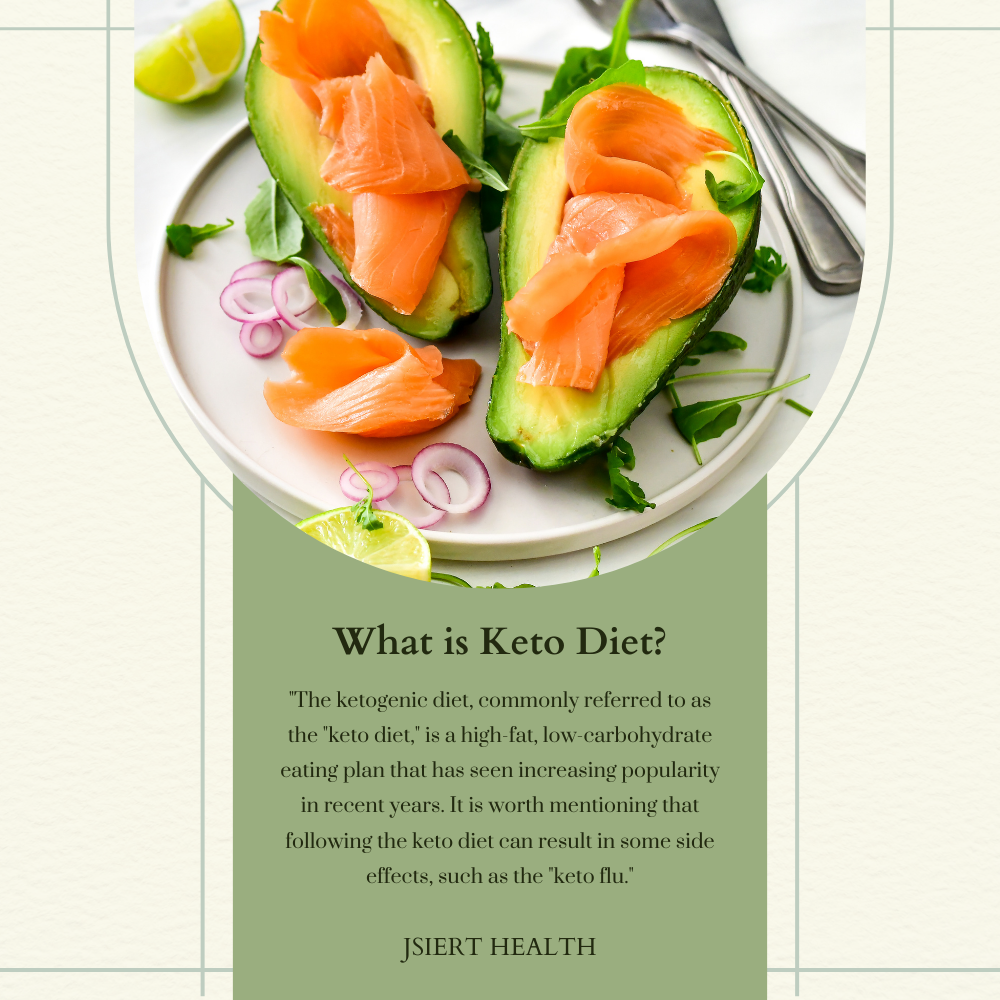
A ketogenic diet, commonly referred to as a keto diet, is a high-fat, low-carbohydrate dietary approach designed to induce a metabolic state known as ketosis. In a traditional Western diet, the body primarily relies on glucose derived from carbohydrates as its main source of energy. However, by significantly reducing carbohydrate intake and replacing it with fats, the keto diet forces the body to shift its primary fuel source from glucose to ketones, which are produced by the liver from fatty acids.
Introduction to the Keto Diet
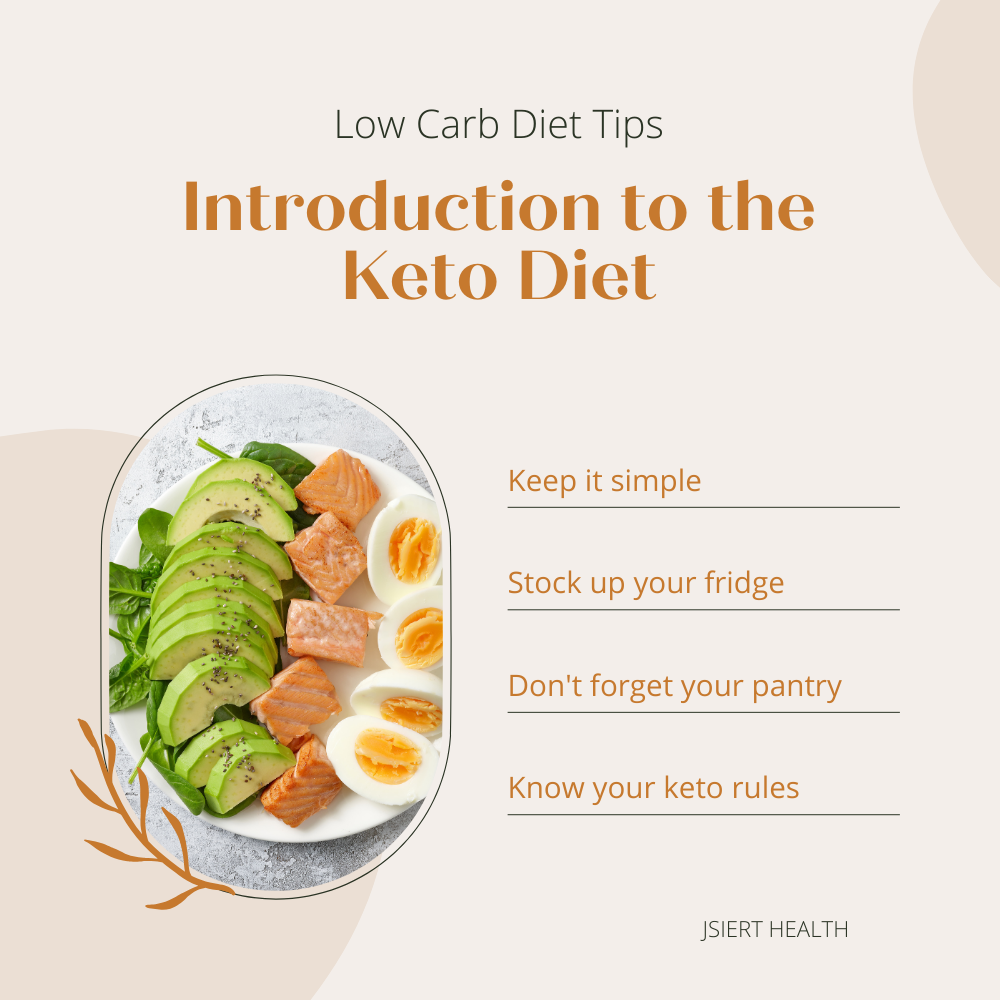
Explanation of the Keto Diet: Detail the concept of the ketogenic diet, which involves drastically reducing carbohydrate intake and replacing it with fats to induce a metabolic state called ketosis.
- Brief History: Discuss the origins of the keto diet, starting with its development in the 1920s as a treatment for epilepsy.
- Metabolic State of Ketosis: Explain how ketosis occurs when the body produces ketone bodies from fat breakdown, which serve as an alternative fuel source when glucose is scarce.
- Health Benefits: Provide an extensive overview of the potential benefits, including weight loss, improved blood sugar control, increased energy levels, and enhanced mental clarity.
- Potential Risks: Detail the possible risks associated with the keto diet, such as nutrient deficiencies, electrolyte imbalances, and adverse effects on cholesterol levels.
- Target Audience: Identify individuals who may benefit from the keto diet, such as those seeking weight loss, metabolic health improvements, or therapeutic benefits for certain medical conditions.
Understanding Ketosis
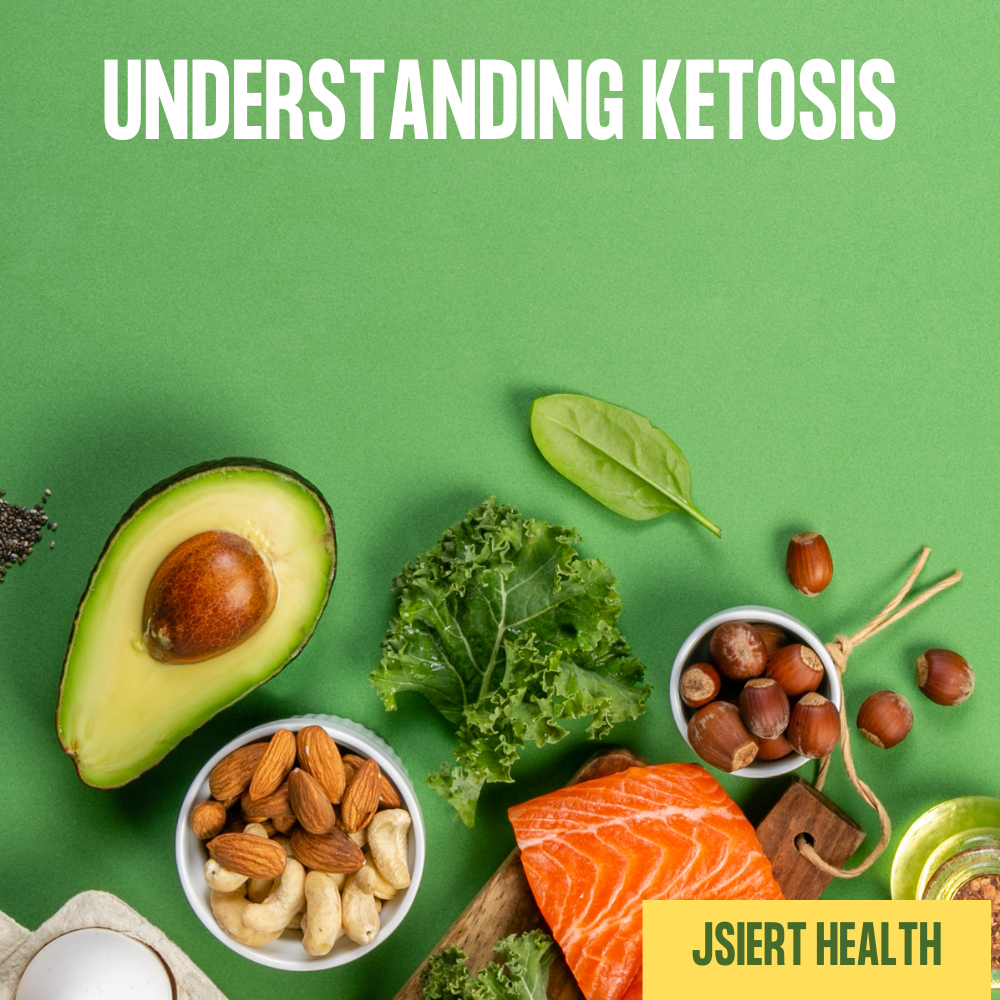
- Metabolic Shift: Explain the metabolic shift from glucose to fat metabolism, highlighting the role of insulin and glucagon in regulating blood sugar levels.
- Ketone Production: Detail the process of ketogenesis, where the liver converts fatty acids into ketone bodies, including acetoacetate, beta-hydroxybutyrate, and acetone.
- Utilization of Ketones: Discuss how ketones are used by various tissues and organs, particularly the brain, muscles, and heart, during periods of carbohydrate restriction.
- Nutritional Ketosis vs. Ketoacidosis: Clarify the distinction between nutritional ketosis, a safe and controlled metabolic state induced by diet, and ketoacidosis, a dangerous condition associated with uncontrolled diabetes or starvation.
- Factors Influencing Ketosis: Explore factors that influence the onset and maintenance of ketosis, such as carbohydrate intake, protein intake, exercise, hydration, and individual metabolic variability.
Principles of the Keto Diet

- Macronutrient Ratios: Provide recommended macronutrient ratios for the keto diet, typically consisting of 70-80% of calories from fat, 20-25% from protein, and 5-10% from carbohydrates.
- Carbohydrate Restriction: Explain the importance of restricting carbohydrates to 20-50 grams per day to achieve and sustain ketosis.
- Role of Fat: Emphasize the role of dietary fat as the primary source of energy on a ketogenic diet, promoting satiety and providing essential fatty acids.
- Protein Moderation: Discuss the need to moderate protein intake to prevent excess gluconeogenesis, where protein is converted into glucose, potentially disrupting ketosis.
- Individualized Approach: Acknowledge the importance of individualized dietary approaches based on factors such as metabolic health, activity level, and personal preferences.
Benefits and Potential Risks
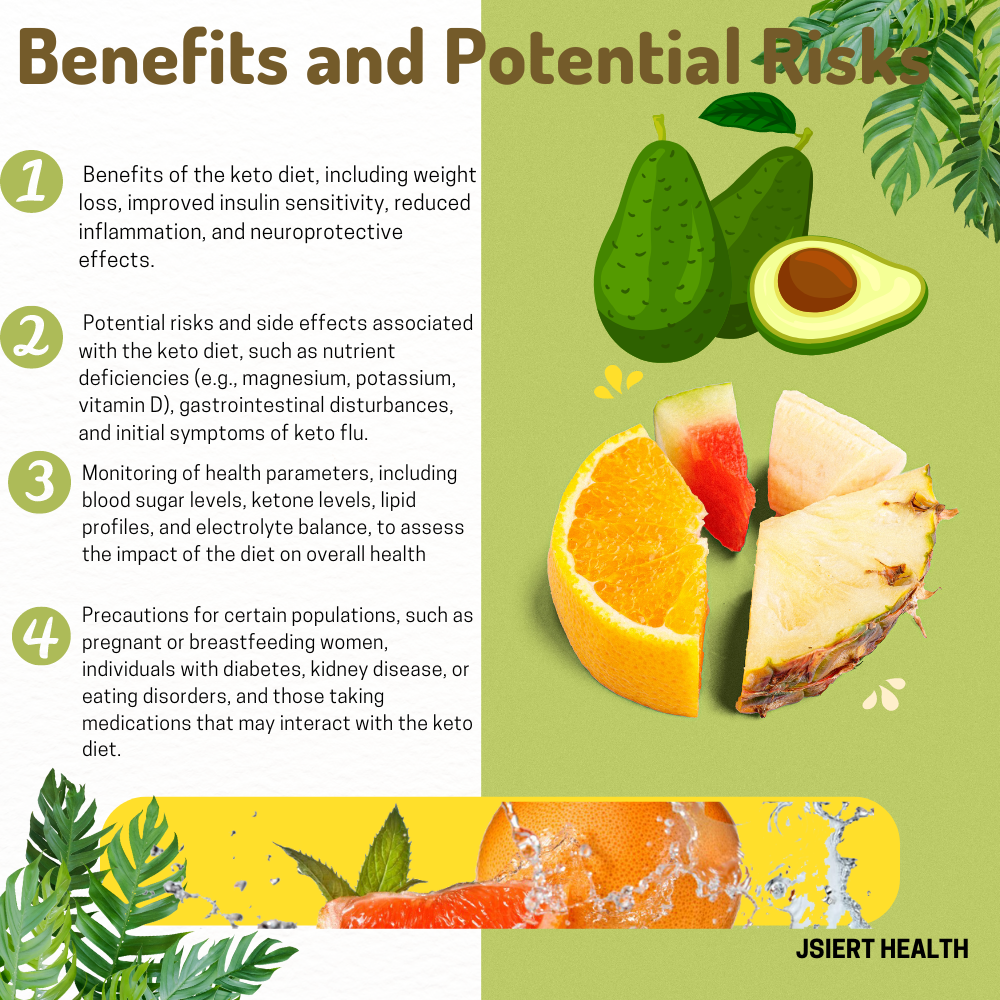
- Evidence-Based Benefits: Provide an in-depth exploration of the evidence supporting the benefits of the keto diet, including weight loss, improved insulin sensitivity, reduced inflammation, and neuroprotective effects.
- Potential Risks and Side Effects: Address potential risks and side effects associated with the keto diet, such as nutrient deficiencies (e.g., magnesium, potassium, vitamin D), gastrointestinal disturbances, and initial symptoms of keto flu.
- Monitoring Health Parameters: Recommend regular monitoring of health parameters, including blood sugar levels, ketone levels, lipid profiles, and electrolyte balance, to assess the impact of the diet on overall health.
- Precautions and Contraindications: Highlight precautions for certain populations, such as pregnant or breastfeeding women, individuals with diabetes, kidney disease, or eating disorders, and those taking medications that may interact with the keto diet.
Foods to Eat on a Keto Diet
1. Healthy Fats:
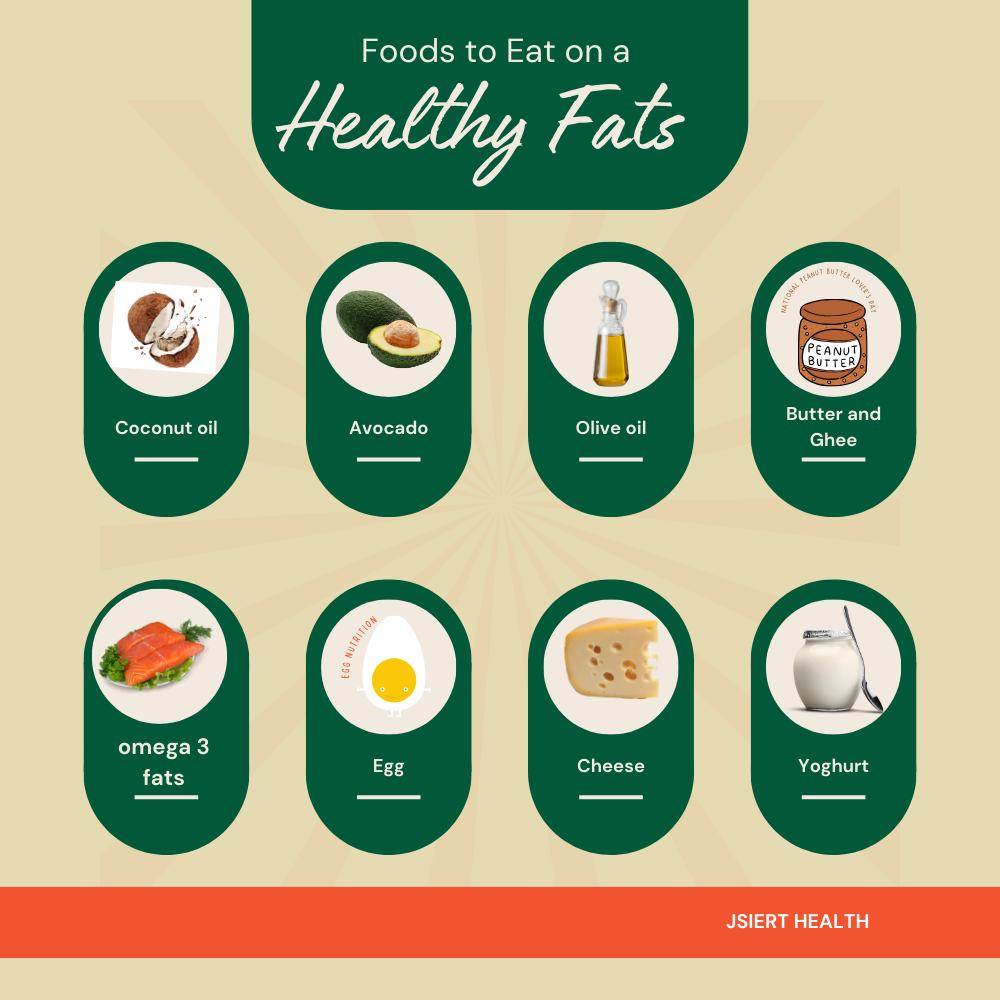
Healthy fats are a staple of the ketogenic diet, providing the majority of daily calories and serving as the primary source of energy. Here are some examples:
- Avocados: Rich in monounsaturated fats, avocados are versatile and can be enjoyed as a snack, added to salads, or used to make guacamole.
- Coconut Oil: Contains medium-chain triglycerides (MCTs), which are quickly converted into ketones by the liver and used for energy. Coconut oil is ideal for cooking and baking.
- Olive Oil: A staple in Mediterranean cuisine, olive oil is high in monounsaturated fats and antioxidants, offering numerous health benefits.
- Butter and Ghee: Both butter and ghee (clarified butter) are excellent sources of saturated fats and add flavor to dishes. Opt for grass-fed butter for added nutrients.
- Fatty Cuts of Meat: Beef, pork, lamb, and poultry with skin are rich in healthy fats. Choose fattier cuts like ribeye steak, pork belly, and chicken thighs.
- Fatty Fish: Salmon, mackerel, sardines, and trout are high in omega-3 fatty acids, which support heart health and reduce inflammation.
- Eggs: Whole eggs, including the yolk, are a nutritious source of healthy fats, protein, and essential vitamins and minerals.
- Nuts and Seeds: Almonds, walnuts, pecans, macadamia nuts, chia seeds, and flaxseeds are packed with healthy fats, fiber, and micronutrients.
- Full-Fat Dairy: Cheese, cream, yogurt, and cottage cheese are rich in saturated fats and can be included in moderation.
2. Protein Sources:
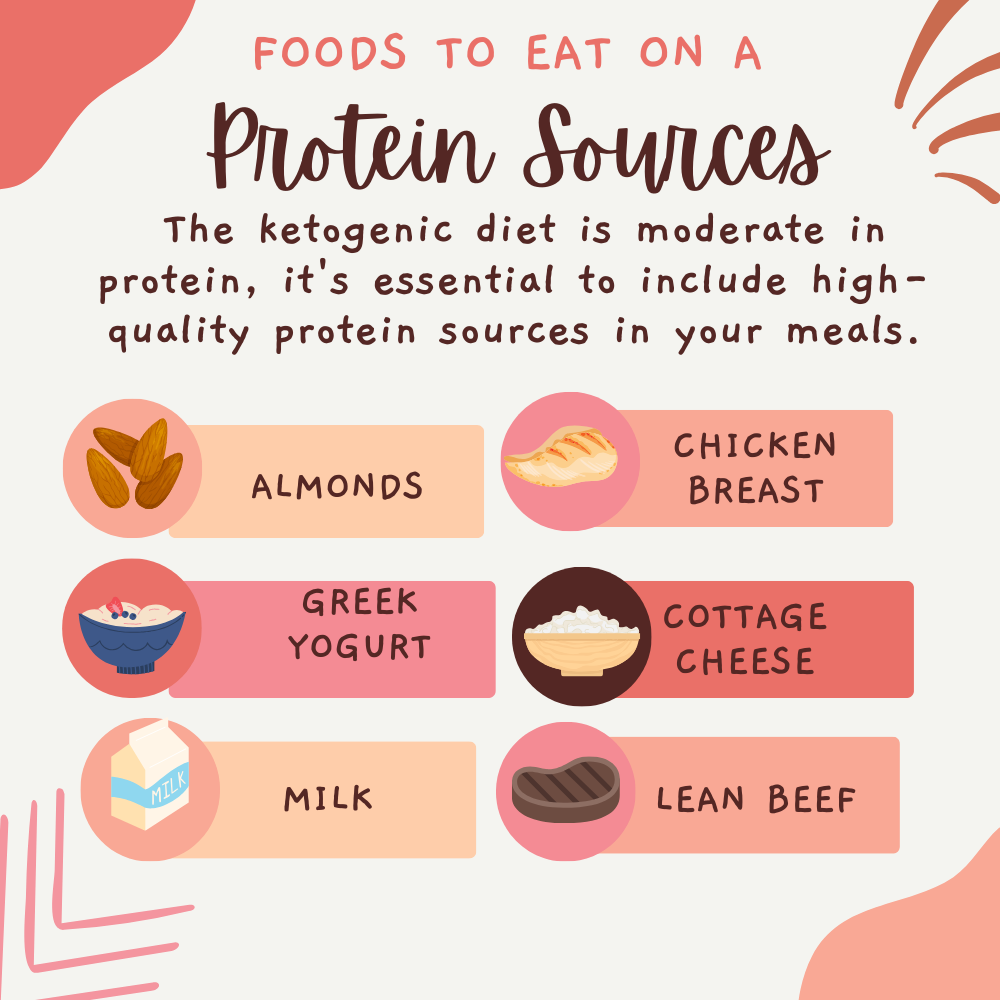
While the ketogenic diet is moderate in protein, it’s essential to include high-quality protein sources in your meals. Here are some examples:
- Meat: Beef, pork, lamb, veal, and game meats are excellent sources of protein and essential nutrients. Choose fatty cuts for added fat content.
- Poultry: Chicken, turkey, duck, and game birds provide lean protein. Opt for dark meat with the skin on for higher fat content.
- Fish and Seafood: Salmon, trout, mackerel, tuna, shrimp, crab, lobster, and mussels are rich in protein and omega-3 fatty acids.
- Eggs: In addition to being high in healthy fats, eggs are a complete source of protein, containing all nine essential amino acids.
- Organ Meats: Liver, heart, and kidneys are nutrient-dense protein sources, providing essential vitamins and minerals like iron, vitamin A, and B vitamins.
- Tofu and Tempeh: Plant-based protein sources like tofu and tempeh are suitable for vegetarian and vegan keto diets.
- High-Fat Dairy: Cheese, yogurt, and cottage cheese provide protein along with healthy fats. Opt for full-fat varieties with minimal added sugars.
3. Low-Carb Vegetables:
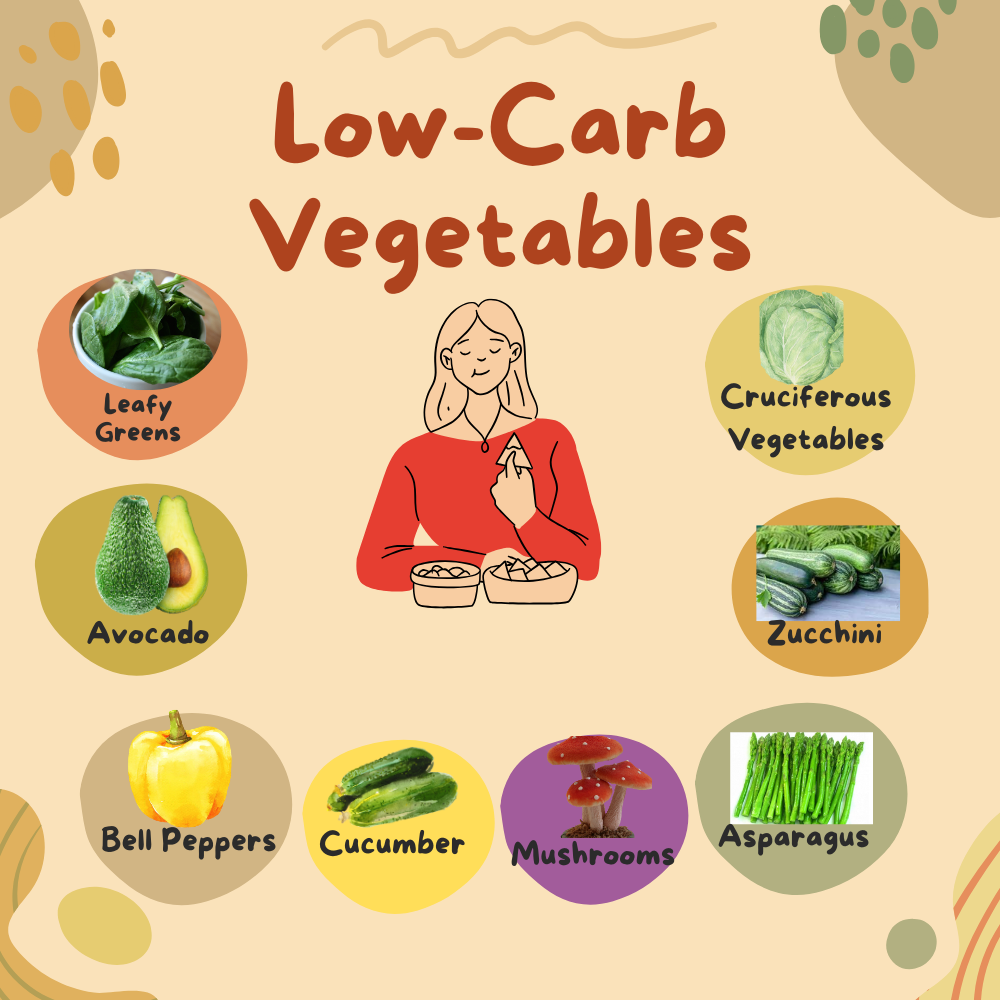
Non-starchy vegetables are an essential component of the ketogenic diet, providing fiber, vitamins, minerals, and antioxidants while keeping carbohydrate intake low. Here are some keto-friendly vegetables:
- Leafy Greens: Spinach, kale, Swiss chard, collard greens, and arugula are low in carbs and high in nutrients.
- Cruciferous Vegetables: Broccoli, cauliflower, Brussels sprouts, cabbage, and bok choy are rich in fiber and antioxidants.
- Avocado: Technically a fruit, avocados are low in carbs and high in healthy fats, fiber, potassium, and vitamins.
- Zucchini: Versatile and low in carbs, zucchini can be spiralized into noodles (zoodles) or sliced and sautéed as a side dish.
- Bell Peppers: Red, green, and yellow bell peppers add color and flavor to keto meals while providing essential nutrients like vitamin C.
- Asparagus: Rich in fiber, asparagus is a low-carb vegetable that can be roasted, grilled, or steamed.
- Mushrooms: Portobello, shiitake, and cremini mushrooms are low in carbs and add umami flavor to keto dishes.
- Cucumber: Refreshing and hydrating, cucumbers are low in carbs and make a crunchy snack or salad ingredient.
4. Dairy Products:

Dairy products can be included in moderation on the ketogenic diet, providing protein, fat, and essential nutrients. Opt for full-fat or high-fat varieties and avoid those with added sugars. Here are some keto-friendly dairy options:
- Cheese: Cheddar, mozzarella, feta, goat cheese, cream cheese, and blue cheese are low in carbs and high in fat and protein.
- Cream: Heavy cream, sour cream, and crème fraîche are suitable for keto cooking and baking.
- Yogurt: Greek yogurt and skyr are lower in carbs than traditional yogurt and can be included in moderation. Choose unsweetened varieties.
- Butter: Butter adds flavor and richness to keto meals and can be used for cooking, frying, and baking.
- Ghee: Clarified butter with the milk solids removed, ghee has a higher smoke point than butter and is suitable for high-heat cooking.
5. Nuts and Seeds:
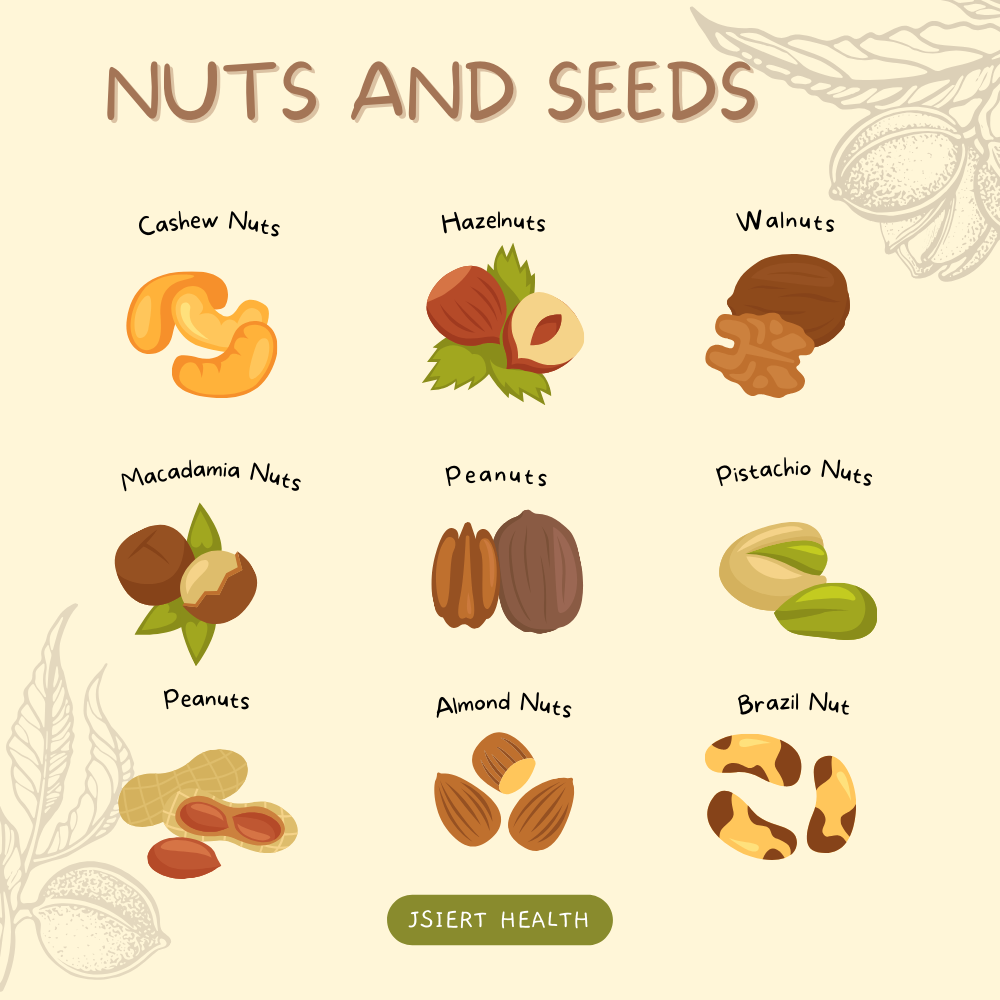
Nuts and seeds are nutrient-dense foods that provide healthy fats, protein, fiber, vitamins, and minerals. However, they should be consumed in moderation on a ketogenic diet due to their calorie and carb content. Here are some keto-friendly nuts and seeds:
- Almonds: Almonds are rich in healthy fats, protein, fiber, vitamin E, magnesium, and antioxidants.
- Walnuts: Walnuts are high in omega-3 fatty acids, which support heart health and reduce inflammation.
- Pecans: Pecans are a good source of monounsaturated fats, fiber, and antioxidants like vitamin E.
- Macadamia Nuts: Macadamia nuts are one of the lowest carb nuts and provide healthy fats, fiber, and minerals like manganese.
- Chia Seeds: Chia seeds are high in fiber and omega-3 fatty acids, which promote satiety and support digestive health.
- Flaxseeds: Flaxseeds are rich in alpha-linolenic acid (ALA), a type of omega-3 fatty acid, and lignans, which have antioxidant properties.
- Pumpkin Seeds: Pumpkin seeds, also known as pepitas, are high in protein, healthy fats, fiber, iron, magnesium, zinc, and antioxidants.
- Sunflower Seeds: Sunflower seeds are a good source of vitamin E, selenium, and other nutrients, and can be enjoyed roasted or raw.
6. Berries:
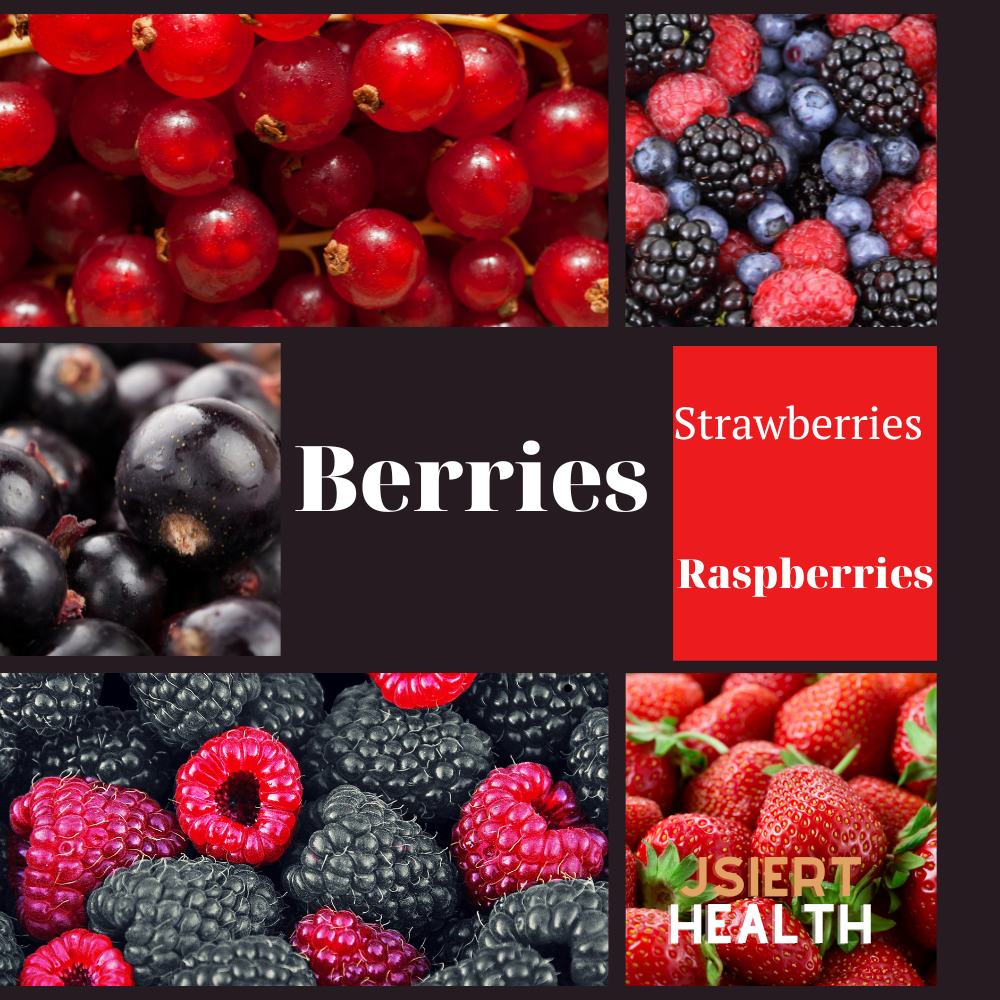
While most fruits are too high in carbs for the ketogenic diet, some berries can be included in moderation due to their lower sugar content. Berries are rich in fiber, vitamins, minerals, and antioxidants while being relatively low in net carbs. Here are some keto-friendly berries:
- Strawberries:
- Rich in Nutrients: Despite their small size, strawberries are packed with essential nutrients. They are an excellent source of vitamin C, manganese, folate (vitamin B9), and potassium. They also contain small amounts of other vitamins and minerals like vitamin K, magnesium, and iron.
- High in Antioxidants: Strawberries are loaded with antioxidants, including flavonoids, phenolic compounds, and vitamin C. These antioxidants help protect the body from oxidative stress and damage caused by free radicals, reducing the risk of chronic diseases such as heart disease, cancer, and neurodegenerative disorders.
- Heart Health: The high levels of antioxidants and polyphenols in strawberries have been associated with improved heart health. They help lower LDL (bad) cholesterol levels, reduce inflammation, improve blood vessel function, and lower blood pressure, thereby reducing the risk of heart disease.
- Support Digestive Health: Strawberries are a good source of dietary fiber, which aids digestion and promotes regular bowel movements. Fiber also helps prevent constipation, reduces the risk of colorectal cancer, and supports a healthy gut microbiome.
- Weight Management: Despite their natural sweetness, strawberries are relatively low in calories and high in fiber, making them a great choice for weight management. The fiber content helps promote satiety and reduce overall calorie intake.
- Blood Sugar Regulation: The fiber and polyphenols in strawberries can help regulate blood sugar levels by slowing down the digestion of carbohydrates and improving insulin sensitivity. This may be beneficial for individuals with diabetes or those at risk of developing the condition.
- Anti-Inflammatory Properties: Some compounds found in strawberries have anti-inflammatory properties, which can help reduce inflammation in the body and alleviate symptoms of inflammatory conditions such as arthritis and asthma.
- Brain Health: The antioxidants and flavonoids in strawberries have been linked to improved cognitive function and reduced cognitive decline with aging. Regular consumption of strawberries may help enhance memory, concentration, and overall brain health.
- Skin Health: The high vitamin C content in strawberries promotes collagen production, which helps maintain skin elasticity and prevents wrinkles and sagging. Additionally, the antioxidants in strawberries protect the skin from damage caused by UV radiation and environmental pollutants.
- Boost Immunity: Vitamin C is well-known for its role in supporting immune function by stimulating the production of white blood cells and enhancing the body’s defense against infections and illnesses. Including strawberries in your diet can help strengthen your immune system.
-
- Raspberries:
- Rich in Nutrients: Raspberries are low in calories but high in fiber, vitamins, and minerals. They are an excellent source of vitamin C, manganese, and vitamin K. They also contain small amounts of other vitamins and minerals like vitamin E, magnesium, potassium, and folate.
- High in Antioxidants: Raspberries are loaded with antioxidants, such as flavonoids, phenolic compounds, and ellagic acid. These antioxidants help neutralize harmful free radicals in the body, reducing oxidative stress and inflammation, and lowering the risk of chronic diseases like heart disease, diabetes, and cancer.
- Support Heart Health: The high content of antioxidants, fiber, and potassium in raspberries supports heart health. Potassium helps regulate blood pressure, while fiber helps lower cholesterol levels, reducing the risk of heart disease.
- Promote Digestive Health: Raspberries are an excellent source of dietary fiber, which promotes digestive health by preventing constipation and supporting regular bowel movements. The fiber also helps maintain a healthy gut microbiota, which is essential for overall health and immune function.
- May Aid Weight Loss: Despite their sweet taste, raspberries are relatively low in calories and high in fiber, making them a great option for weight management. The fiber helps keep you feeling full for longer periods, reducing overall calorie intake.
- Anti-inflammatory Properties: Some compounds found in raspberries have anti-inflammatory properties, which may help reduce inflammation in the body and alleviate symptoms of inflammatory conditions like arthritis.
- Support Brain Health: The antioxidants in raspberries, particularly flavonoids, may help improve cognitive function and protect against age-related decline in brain function. Some studies suggest that consuming berries regularly may help prevent cognitive impairment and neurodegenerative diseases like Alzheimer’s.
- Boost Immunity: The high vitamin C content in raspberries supports immune function by stimulating the production of white blood cells and enhancing the body’s defense against infections and illnesses.
- Promote Skin Health: The antioxidants in raspberries help protect the skin from damage caused by UV rays and environmental pollutants, reducing signs of aging like wrinkles and age spots. Additionally, the vitamin C content promotes collagen production, keeping the skin firm and youthful.
Meal Planning and Preparation
Meal planning and preparation are essential components of success on the ketogenic diet. By carefully selecting and preparing meals ahead of time, you can ensure that you meet your macronutrient targets, enjoy delicious and satisfying meals, and stay on track with your health and fitness goals. In this section, we’ll explore strategies for effective meal planning and preparation on a keto diet, including tips for grocery shopping, pantry stocking, cooking techniques, batch cooking, and meal prep.
1. Meal Planning Strategies:
Meal planning involves deciding what to eat for each meal and snack throughout the week. Here are some strategies to streamline the process and make meal planning on a keto diet more manageable:
- Set Goals: Determine your macronutrient targets based on your individual needs, goals, and activity level. Aim for a daily intake of 70-80% of calories from fat, 20-25% from protein, and 5-10% from carbohydrates.
- Create a Weekly Menu: Plan your meals for the week, including breakfast, lunch, dinner, and snacks. Use recipes and meal ideas that align with your macronutrient targets and dietary preferences.
- Variety is Key: Incorporate a variety of foods and flavors into your meals to keep things interesting and prevent boredom. Experiment with different proteins, vegetables, fats, and seasonings to create delicious and satisfying dishes.
- Consider Convenience: Choose recipes and meal ideas that are easy to prepare and can be made in batches or ahead of time. Look for simple and quick recipes that require minimal ingredients and cooking techniques.
- Plan for Leftovers: Cook larger batches of meals and portion them out for leftovers. Leftovers can be enjoyed for lunch or dinner the next day or frozen for future meals.
- Be Flexible: Be flexible with your meal plan and adjust it as needed based on changes in schedule, appetite, or preferences. Don’t be afraid to swap out ingredients or meals if necessary.
2. Grocery Shopping Tips:
Effective grocery shopping is essential for stocking your kitchen with keto-friendly foods and ingredients. Here are some tips to make your grocery shopping trips more efficient and successful:
- Make a List: Create a shopping list based on your weekly meal plan and the ingredients you need. Organize your list by food categories (e.g., produce, dairy, meats) to streamline your shopping trip.
- Read Labels: Be mindful of reading labels and checking the nutritional information on packaged foods. Look for products with minimal added sugars, fillers, and preservatives.
- Shop the Perimeter: Focus on shopping the perimeter of the grocery store, where you’ll find fresh produce, meats, dairy, and other whole foods. Limit your time in the center aisles, which contain processed and high-carb foods.
- Stock Up on Staples: Keep your pantry stocked with keto-friendly staples like oils, spices, nuts, seeds, canned goods, and low-carb sweeteners. This will make meal prep easier and ensure you always have ingredients on hand for quick and easy meals.
- Buy in Bulk: Consider buying certain items in bulk to save money and ensure you always have essentials on hand. This includes items like meat, poultry, fish, nuts, seeds, and non-perishable goods.
- Choose Seasonal Produce: Opt for seasonal produce when possible, as it tends to be fresher, more flavorful, and less expensive. Seasonal vegetables can add variety and nutrition to your meals while keeping costs down.
3. Pantry Stocking Essentials:
Stocking your pantry with keto-friendly essentials is key to success on the ketogenic diet. Here are some essential pantry items to have on hand:
- Healthy Fats: Coconut oil, olive oil, avocado oil, butter, ghee, and MCT oil.
- Low-Carb Flours: Almond flour, coconut flour, and flaxseed meal for baking and cooking.
- Nuts and Seeds: Almonds, walnuts, pecans, macadamia nuts, chia seeds, flaxseeds, and pumpkin seeds for snacking and cooking.
- Canned Goods: Canned tuna, salmon, sardines, chicken, and vegetables for quick and convenient meals.
- Broths and Stocks: Beef, chicken, or vegetable broth for soups, stews, and sauces.
- Condiments and Sauces: Mustard, mayonnaise, hot sauce, soy sauce, tamari, vinegar, and sugar-free ketchup and barbecue sauce.
- Spices and Seasonings: Salt, pepper, garlic powder, onion powder, paprika, chili powder, cumin, Italian seasoning, and herbs like basil, oregano, and thyme.
- Low-Carb Sweeteners: Stevia, erythritol, monk fruit, and sugar-free syrups for sweetening beverages and desserts.
4. Cooking Techniques for Keto Meals:
Cooking techniques play a crucial role in preparing delicious and satisfying keto meals. Here are some cooking methods that are suitable for the ketogenic diet:
- Grilling: Grilling is a healthy and flavorful way to cook meats, poultry, fish, and vegetables. Marinate proteins in keto-friendly sauces or seasonings before grilling for added flavor.
- **Roasting**: Roasting is an easy and versatile cooking method that brings out the natural flavors of foods. Simply toss vegetables or meats with olive oil, salt, and spices, then roast in the oven until golden and caramelized.
- Sautéing: Sautéing vegetables, meats, or seafood in a skillet with oil or butter is a quick and convenient way to cook keto-friendly meals. Add garlic, onions, herbs, or spices for extra flavor.
- Baking: Baking is a popular cooking technique for preparing keto-friendly baked goods like bread, muffins, cookies, and cakes using low-carb flours like almond flour or coconut flour. Experiment with keto-friendly recipes to satisfy your sweet tooth.
- Slow Cooking: Slow cooking is perfect for busy days when you want a hearty and comforting meal with minimal effort. Prepare keto-friendly soups, stews, chili, or roasts in a slow cooker and let it simmer for hours until tender and flavorful.
- Steaming: Steaming vegetables preserves their nutrients and natural flavors while keeping them tender-crisp. Steam broccoli, cauliflower, asparagus, or Brussels sprouts until just cooked through, then season with butter or olive oil.
- Frying: Frying foods in healthy fats like coconut oil or avocado oil can add crispy texture and delicious flavor. Use a low-carb breading or coating for meats, fish, or vegetables to keep them keto-friendly.
- Instant Pot Cooking: The Instant Pot is a versatile kitchen appliance that can be used to cook a wide variety of keto-friendly meals quickly and efficiently. Prepare soups, stews, meats, and even desserts in a fraction of the time compared to traditional cooking methods.
5. Batch Cooking and Meal Prep:
Batch cooking and meal prep are essential strategies for saving time and staying consistent with your keto diet. Here’s how to incorporate batch cooking and meal prep into your routine:
- Choose Batch-Friendly Recipes: Select recipes that are easy to scale up and suitable for batch cooking. One-pot meals, casseroles, soups, and stir-fries are ideal options.
- Schedule a Cooking Day: Dedicate one day a week to batch cooking and meal prep. Set aside a few hours to cook multiple meals in advance and portion them out for the week.
- Invest in Storage Containers: Invest in a variety of storage containers, including glass containers, meal prep containers, and freezer-safe bags, to store your prepared meals and ingredients.
- Portion Control: Portion out your meals into individual servings to prevent overeating and make it easy to grab a meal on the go. Use measuring cups, food scales, or portion control containers to ensure accuracy.
- Label and Date: Label your containers with the name of the dish and the date it was prepared to keep track of freshness and prevent food waste.
- Store Properly: Store prepared meals and ingredients in the refrigerator or freezer, depending on their shelf life. Use airtight containers or bags to maintain freshness and prevent freezer burn.
- Reheat Safely: When reheating meals, use a microwave, stovetop, or oven until heated through. Be sure to follow proper food safety guidelines to prevent foodborne illness.
- Rotate Stock: Rotate your stocked meals and ingredients regularly to ensure that nothing goes to waste. Use older items first and replenish your stock as needed during your next batch cooking session.
6. Sample Meal Prep Ideas:
Here are some sample meal prep ideas to get you started:
- Breakfast: Crustless quiche with spinach, bacon, and cheese; portioned into individual servings for easy grab-and-go breakfasts throughout the week.
- Lunch: Chicken Caesar salad jars with grilled chicken, romaine lettuce, cherry tomatoes, Parmesan cheese, and Caesar dressing; assembled in Mason jars for convenient lunches at work.
- Dinner: Beef and broccoli stir-fry with sliced beef, broccoli florets, bell peppers, and mushrooms; portioned into containers with cauliflower rice for quick and healthy dinners.
- Snacks: Hard-boiled eggs, cheese cubes, sliced cucumbers, and almond butter energy balls; pre-portioned into snack-sized containers for convenient snacking between meals.
By incorporating these meal planning and preparation strategies into your routine, you can stay on track with your keto diet goals, save time in the kitchen, and enjoy delicious and satisfying meals every day. Experiment with different recipes, flavors, and cooking techniques to keep things exciting and prevent boredom. With a little planning and preparation, you can set yourself up for success on your keto journey.
Tips for Success and Troubleshooting
- Setting Realistic Goals: Encourage readers to set realistic and sustainable goals for their keto journey, focusing on long-term health and well-being rather than short-term weight loss.
- Staying Consistent: Provide strategies for staying consistent on the keto diet, such as meal planning, tracking progress, seeking support from peers or online communities, and practicing self-
- Managing Cravings: Offer practical tips for managing cravings on the keto diet, including consuming satisfying meals that are high in healthy fats and protein, staying hydrated, distracting oneself with non-food activities, and incorporating occasional treats using keto-friendly alternatives.
- Navigating Social Situations: Provide guidance on navigating social situations and dining out while following a keto lifestyle, such as planning ahead, communicating dietary preferences with hosts or restaurant staff, and making informed choices from menu options.
- Stress Management: Emphasize the importance of stress management techniques, such as mindfulness, meditation, deep breathing exercises, and regular physical activity, in supporting overall health and adherence to the keto diet.
- Overcoming Plateaus and Stalls: Offer strategies for overcoming plateaus and stalls in weight loss or progress on the keto diet, such as reassessing macronutrient ratios, increasing physical activity, experimenting with intermittent fasting, or incorporating metabolic resets.
- Addressing Adverse Reactions: Provide guidance on addressing adverse reactions or side effects experienced on the keto diet, such as adjusting macronutrient ratios, increasing electrolyte intake, consulting with a healthcare professional, and considering alternative dietary approaches if necessary.
Conclusion
- Summary of Key Points: Recap the key points covered in the guide, including the principles of the keto diet, recommended foods, meal planning strategies, and tips for success.
- Encouragement and Motivation: Offer words of encouragement and motivation for readers embarking on or continuing their keto journey, emphasizing the potential benefits of improved health, vitality, and well-being.
- Individualized Approach: Highlight the importance of adopting an individualized approach to the keto diet, listening to one’s body, and making adjustments based on personal preferences, goals, and feedback.
- Resources for Further Support: Provide resources for further reading, including books, websites, online communities, and certified keto coaches or practitioners, to support readers in their ongoing journey toward health and vitality through the ketogenic lifestyle.
Some frequently asked questions (FAQs) about the ketogenic diet along with their answers:
- What is a ketogenic diet?
- A ketogenic diet, often referred to as keto diet, is a high-fat, low-carbohydrate dietary approach designed to induce a metabolic state called ketosis. By drastically reducing carbohydrate intake and replacing it with fats, the body shifts its primary fuel source from glucose to ketones, which are produced by the liver from fatty acids.
- How does the ketogenic diet work?
- The ketogenic diet works by restricting carbohydrate intake, which lowers blood sugar and insulin levels, prompting the body to burn fat for fuel. This metabolic state, known as ketosis, results in the production of ketone bodies, which are used by cells for energy instead of glucose.
- What foods can I eat on a ketogenic diet?
- Foods allowed on a ketogenic diet include:
- Healthy fats like avocados, coconut oil, olive oil, butter, and fatty cuts of meat.
- Protein sources such as meat, poultry, fish, eggs, and tofu.
- Low-carb vegetables like leafy greens, broccoli, cauliflower, and zucchini.
- Nuts, seeds, and berries in moderation.
- Dairy products like cheese, yogurt, and cream (full-fat versions preferred).
- Foods allowed on a ketogenic diet include:
- What foods should I avoid on a ketogenic diet?
- Foods to avoid on a ketogenic diet include:
- High-carb foods such as bread, pasta, rice, and sugary snacks.
- Starchy vegetables like potatoes, corn, and peas.
- Most fruits except for small portions of berries.
- Processed foods containing added sugars and refined carbohydrates.
- Sugary beverages, including sodas, juices, and sweetened drinks.
- Foods to avoid on a ketogenic diet include:
- Is the ketogenic diet safe?
- The ketogenic diet is generally considered safe for most healthy individuals when followed appropriately. However, it may not be suitable for everyone, and there can be potential risks and side effects, such as nutrient deficiencies, electrolyte imbalances, and gastrointestinal issues. It’s essential to consult with a healthcare professional before starting any new diet, especially if you have underlying health conditions or concerns.
- What are the potential benefits of the ketogenic diet?
- The ketogenic diet has been associated with various potential benefits, including:
- Weight loss and fat loss.
- Improved blood sugar control and insulin sensitivity.
- Increased energy levels and mental clarity.
- Enhanced cognitive function and mood.
- Reduced inflammation and improved markers of cardiovascular health.
- The ketogenic diet has been associated with various potential benefits, including:
- How quickly can I expect to see results on a ketogenic diet?
- Results on a ketogenic diet can vary depending on individual factors such as starting weight, metabolic rate, activity level, and adherence to the diet. Some people may experience rapid weight loss and improved energy levels within the first few weeks of starting a ketogenic diet, while others may take longer to adapt to ketosis and see noticeable changes.
- Can I exercise while on a ketogenic diet?
- Yes, exercise can be compatible with a ketogenic diet and may even enhance its benefits, such as fat loss and metabolic health improvements. However, it’s essential to listen to your body, stay hydrated, and adjust your exercise intensity as needed, especially during the initial transition period when your body is adapting to using ketones for fuel.
- Are there any potential side effects of the ketogenic diet?
- Some individuals may experience temporary side effects when starting a ketogenic diet, often referred to as the “keto flu.” These side effects may include fatigue, headache, dizziness, nausea, and constipation. However, they are usually short-lived and can be mitigated by staying hydrated, consuming electrolytes, and gradually transitioning to ketosis.
- Is the ketogenic diet suitable for long-term use?
- While the ketogenic diet can be effective for short-term weight loss and metabolic improvements, its long-term sustainability and safety are still being studied. Some people may choose to follow a ketogenic lifestyle indefinitely, while others may use it as a temporary intervention to achieve specific health goals before transitioning to a more balanced approach. It’s essential to find a dietary pattern that works for you and supports your overall health and well-being.